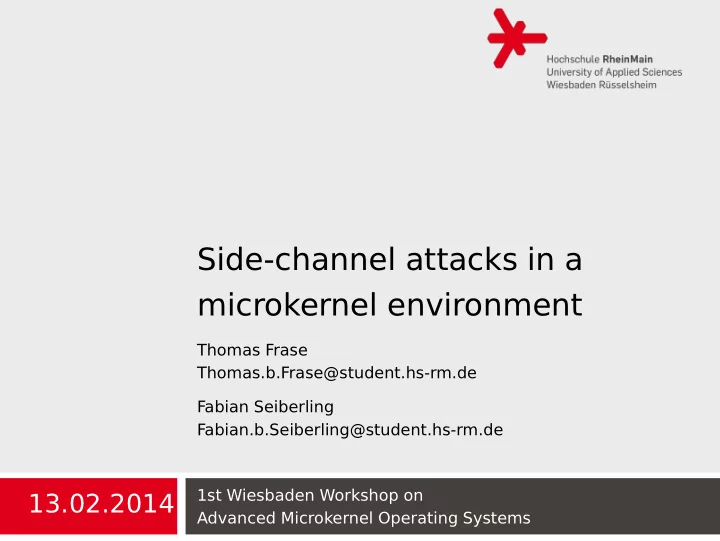

Side-channel attacks in a microkernel environment Thomas Frase Thomas.b.Frase@student.hs-rm.de Fabian Seiberling Fabian.b.Seiberling@student.hs-rm.de 1st Wiesbaden Workshop on 13.02.2014 Advanced Microkernel Operating Systems
Table of contents 2 Introduction 1 2 Public Key Cryptography 3 Side-channel Attacks Real-world Examples 4 Conclusion 5
Introduction 3 Side-channel attacks use the physical implementation of a cryptographic function to gain information about the key. Cryptographic Implementation Ciphertext Decryption function Message Key Side-channel information Side-channel attack
Public Key Cryptography 4 Alice Bob Generate big primes p and q
Public Key Cryptography 4 Alice Bob Calculate n = p · q
Public Key Cryptography 4 Alice Bob Find e with gcd ( e , n ) = 1
Public Key Cryptography 4 Alice Bob Find d with e · d ≡ 1 ( mod n )
Public Key Cryptography 4 Alice Bob Public key: ( e , n ) Private key: ( d , n )
Public Key Cryptography 4 Public Key ( e , n ) Alice Bob
Public Key Cryptography 4 Alice Bob Encrypt mes- sage: c = m e ( mod n )
Public Key Cryptography 4 Encrypted message c Alice Bob
Public Key Cryptography 4 Alice Bob Decrypt mes- sage: m = c d ( mod n )
Exponentiation by squaring 5 Algorithm Input : c , d , n Output : m let d 1 , ..., d n be the bits of d ; let bits ( x ) be the bit-length of x ; m ← 1; for i = bits ( d ) down to 1 do m ← m 2 ( mod n ) ; if d i = 1 then m ← m · c ( mod n ) ; end end
Side-channel Attacks 6 Types of side channel attacks: Acoustic cryptanalysis Data remanence Differential fault analysis Electromagnetic attacks Power monitoring attack Timing attack
Side-channel Attacks 7 Acoustic cryptanalysis Attacks which use the noise emitted by the computer while using the cryptographic function. Data remanence attacks which use to read the data which was used by a cryptographic function. The data can be restored after the cryptographic function delete them.
Side-channel Attacks 8 Differential fault analysis This attack create a fault in the cryptographic function to gain information about the current state of the function. A fault can be created with high temperature, to high or low voltage or with electric or magnetic fields. Electromagnetic attacks Attacks which use the electromagnetic field to gain information about the secret of the cryptographic function.
Side-channel Attacks 9 Power monitoring attack This attack used the characteristic of the power consumption for each instruction of the CPU. Timing attack Attacks which measure the execution time of parts of the cryptographic function to gain information.
Example: Power monitoring attack 10 Square-and-multiply algorithm Different amount of power Digital oscilloscope Differential power analysis
Acoustic Attack 11 Genkin, Shamir and Tromer RSA Key Extraction via Low-Bandwidth Acoustic Cryptanalysis Extraction of full 4096-bit RSA key Attack using various microphones Uses adaptive chosen-ciphertext Target: GnuPG on Laptops
Acoustic Attack 12 Electrical components produce high-frequency noise Voltage regulator noise depends heavily on CPU instructions / load Various CPU instructions distinguishable in acoustic spectrum
Acoustic Attack 13 GnuPG uses optimization (RSA-CRT) m p = c d p m q = c d q ( mod p ) ( mod q ) Attack targets each bit of q individually Choose c Determine q i = 1 or q i = 0 Modify c according to last step Repeat Factorize n from q
Acoustic Attack 14 Consequences for microkernels? Attack is independent of operating system Mitigation best done on algorithm-level Self-eavesdropping can be mitigated by considering the microphone a security critical resource
Access-driven Cross-VM Attack 15 Yinqian, Juels, Reiter, and Ristenpart Cross-VM Side Channels and Their Use to Extract Private Keys Almost complete extraction of private key Required brute-force search of about 10,000 keys Target: GnuPG in a Xen-based VM
Access-driven Cross-VM Attack 16 Attacker and victim on different guest VMs Attacker spies on the instruction cache Cache-based delays reveals used code paths in victim
Access-driven Cross-VM Attack 17 Preempting the victim Noise-reduction Classification SVM (Support vector machines) HMM (Hidden Markov model) Fragment stitching
Access-driven Cross-VM Attack 18 Consequences for microkernels? Side-channel resistant algorithms Scheduling Make it hard for the attacker to preempt the victim Flushing caches Flush instruction cache on context switch for critical tasks
Conclusion 19 Side-channel attacks can be used on a microkernel Some attacks can be prevented by additional security Implementations on the microkernel Some attacks can only prevented by changing the Implementation of the cryptographic function
Recommend
More recommend